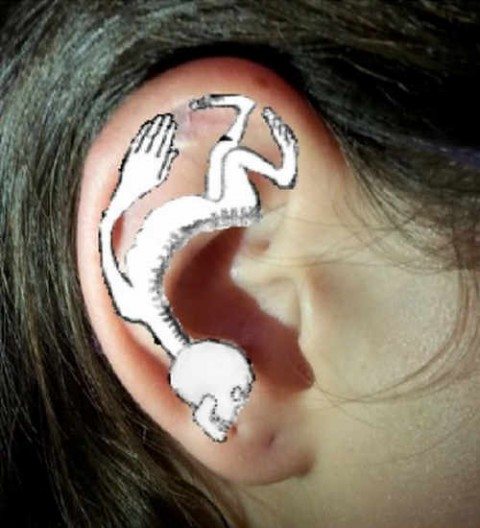
Legitimately prescribed drugs can be stolen from a medicine cabinet a few at a time, usually without notice. From the Iowa Governor’s Office of Drug Control Policy.
Ohio recently issued Acute Pain Prescribing Guidelines as part of an effort to reduce the epidemic of opioid abuse and death from overdose. They were drafted under the auspices of the Governor’s Cabinet Opiate Action Team (GCOAT), assisted by medical organizations and other groups.
The guidelines include recommendations for non-pharmacologic treatment, a typical feature of pain treatment guidelines and a worthy effort to avoid prescribing opioids for pain. Unfortunately, the guidelines include treatments that are not evidence based and potentially harmful. We’ll return to that issue shortly.
But first, a brief look at the extent of the opioid problem. According to the CDC, opioids are used to treat moderate-to-severe pain and are often prescribed following surgery, injury, or for painful health conditions, like cancer. In the past few years, there has been a dramatic increase in the acceptance and use of prescription opioids for the treatment of chronic, non-cancer pain, such as back pain or osteoarthritis. From 1999 to 2013, opioid prescription and sales in the U.S. have nearly quadrupled, and overdose deaths have quadrupled right along with them.
The most common drugs involved in prescription overdose deaths include:
- Hydrocodone (e.g., Vicodin)
- Oxycodone (e.g., OxyContin)
- Oxymorphone (e.g., Opana)
- Methadone (especially when prescribed for pain)
44 people in the U.S. die from overdose of prescription painkillers every day, and a big part of the overdose problem results from prescription opioid painkillers. These drugs can be highly addictive – in some cases, all it takes is one prescription. Once addicted, it can be hard to stop. In 2013, nearly two million Americans abused prescription painkillers. Almost 7,000 people are treated in emergency departments each day for using these drugs in a manner other than as directed.
There is wide variation in opioid prescribing between states that can’t be explained by state differences in health issues that cause people pain. Because the states have the authority to regulate health care practices, they are at the front lines of strategies to reduce improper prescribing and overdose.
State prescription drug monitoring programs (PDMPs) and regulation of pain clinics have shown promising results. My state, Florida, became well known for its “pill mills” and Broward County (Ft. Lauderdale) was ground zero for the industry. In 2010, there were more pill mills than McDonald’s restaurants in the county, and people were driving in from states like Tennessee and Kentucky for their meds. (The local sheriff speculated that Broward’s popularity as a drug destination was due to “better beaches.”) That year, the state enacted more stringent pain clinic regulations and stopped practitioners from dispensing prescription painkillers from their offices. By 2012, there was a 50% decrease in oxycodone overdose deaths.
Where one-stop shopping isn’t available, one strategy used by addicts is to see multiple providers for painkillers. In 2012, both New York and Tennessee began requiring prescribers to check the state’s PDMP before prescribing painkillers. By 2013, these states had a 75% and a 36% drop, respectively, in patients seeing multiple providers for the same drugs.
Like Ohio, several states and medical organizations have issued prescribing guidelines for practitioners, as has the CDC (now in draft), although not without criticism. (These guidelines are for chronic pain, while Ohio’s are for acute pain, but they share recommendations that are addressed in this post.)
According to the Institute of Medicine,
trustworthy clinical practice guidelines appropriately manage conflict of interest, use systematic reviews of the evidence to inform recommendations, and rate the strength of the evidence and recommendations.
A common element of opioid prescribing guidelines is the recommendation that practitioners try non-opioid pharmacologic treatment (e.g., NSIADS) and non-pharmacologic treatment for pain. That is certainly reasonable in appropriate situations – no opioids, no addiction and no overdoses. Ohio’s new Guidelines for non-pharmacologic treatment of acute pain include (emphasis mine):
- Ice, heat, positioning, bracing, wrapping, splints, stretching
- Massage therapy, tactile stimulation, acupuncture/acupressure, chiropractic adjustment, osteopathic neuromusculoskeletal medicine
- Biofeedback
- Directed exercise such as physical therapy
The guidelines received a fair amount of attention in the Ohio media. Unfortunately, in one media report, Dr. Mary DiOrio, medical director for the state Department of Health, stretched the guidelines even further by saying “seeing a chiropractor” was an appropriate alternative to drug therapy.
I could find no report or discussion of the research backing up these recommendations. Even without that information, one can confidently conclude that acupuncture, acupressure and chiropractic adjustments are not evidence-based recommendations.
Acupuncture can be readily dispensed with, as the lack of convincing research supporting its effectiveness for pain (or anything else) has been widely discussed on SBM. Acupuncture is nothing more than a theatrical placebo. SBM has an excellent short description of acupuncture, plus many additional posts. To summarize:
- There is no plausible basis in science for the notion that a mysterious force called “qi” runs through the body along “meridians” or that sticking needles in certain points along those meridians can affect any bodily function.
- Attempts to provide a scientific rationale for acupuncture’s putative effects have failed to come up with a plausible explanation.
- It doesn’t matter where you stick the needles, or if you use needles at all.
- All the evidence, taken together, leads to the inevitable conclusion that acupuncture doesn’t work. For anything.
Acupressure is based on the same pre-scientific idea as acupuncture, except that it uses pressure instead of needle insertion. There is no more reason to think it would work, and no more reason to believe any study that “shows it works,” than there is for acupuncture. There is another form of acupressure, auricular acupressure, which suffers from, again, the same fantastical explanation of its supposed mechanism of action as well as lack of evidence of effectiveness. Here, a picture is worth a thousand words:

How auricular acupressure “works.”
Ohio should “adjust” the Guidelines
Whatever the mistakes made in recommending acupuncture/acupressure, I have to believe that GCOAT and its collaborators knew what acupuncture is, at least in its needle acupuncture form. But I also have to believe this group (with one exception) had no idea what they were doing when they recommended “chiropractic adjustments.” I imagine they thought that “chiropractic adjustment” is simply another name for spinal manipulation.
Here’s what the GCOAT needs to know: Spinal manipulation and the “chiropractic adjustment” are two entirely different concepts, although easily confused by those who aren’t familiar with chiropractic lingo.
Chiropractors, and only chiropractors, believe in the existence of the “subluxation” and the ability of “chiropractic adjustments” to “correct” them. They use the term “subluxation” differently than the medical profession and physical therapists, to whom it means a partial dislocation of a joint, such as a dislocated shoulder. Chiropractors define subluxation (or one of its many synonyms, like “joint dysfunction” or “neurobiomechanical lesion” or “vertebral subluxation complex”) as
a health concern that manifests in the skeletal joints, and, through complex anatomical and physiologic relationships, affects the nervous system and may lead to reduced function, disability, or illness.
They’ve never been able to explain what these “anatomical and physiologic relationships” are and how they “affect the nervous system” or “lead to reduced function, disability, or illness” in any way that accords with basic anatomy or physiology. Nevertheless, chiropractors purport to be able to detect these mythical subluxations (sometimes with x-rays, thereby exposing the patient to totally unnecessary radiation) and “correct” them with “adjustments,” all to the purported, but never proven, benefit to the patient’s health.
What does this have to do with spinal manipulation? Spinal manipulation is a legitimate manual therapy used by physical therapists, osteopathic physicians, medical physicians and some evidence-based chiropractors. According to SBM’s own Sam Homola:
Recent reviews of the literature indicate that manipulation may not be any more effective than other treatment methods in affecting the ultimate outcome in recovery from back pain. For symptomatic relief of uncomplicated mechanical-type back pain, however, use of hands-on manipulation may provide more immediate and dramatic relief by stretching tight muscles and mobilizing the spine.
But only chiropractors who believe in the non-existent subluxation (and these are in the majority) use “spinal manipulation” as a synonym for the “chiropractic adjustment,” the purpose of which is to “realign” the spine and get rid of the subluxation. Again, according to Dr. Homola:
Endorsement of the use of manipulation in the treatment of mechanical-type back pain is not an endorsement of chiropractic adjustments used to correct subluxations or some other “joint disturbance” alleged to cause illness or poor health.
Nor is it appropriate to use the term “chiropractic adjustment” when describing spinal manipulation as an appropriate manual therapy for pain.
GCOAT might have legitimately recommended spinal manipulation as a non-pharmacologic treatment (putting aside the issue of its questionable effectiveness). But, in using the term “chiropractic adjustment,” it adopted a pseudoscientific treatment, the “adjustment,” for a pseudoscientific condition, the “subluxation.” If GCOAT would like to see examples of Ohio chiropractors who subscribe to these beliefs, here are a few: from Chiropractic Care for Women (Columbus), Upper Arlington Family Chiropractic (Upper Arlington), and Chagrin Natural Health Clinic (Chagrin Falls).
Patient belief in the efficacy of chiropractic adjustments is not without consequences. A chiropractor adjusts the spine at the location of the “subluxation,” which may not be where the patient is actually experiencing his pain, as in this notorious example. Some chiropractors adjust the cervical spine exclusively, which can cause an arterial dissection leading to a stroke. (Despite chiropractors’ unconvincing protestations to the contrary.)
In addition to these risks, patients being subjected to worthless treatments due to chiropractic belief in the “subluxation” and “adjustments” to correct it have been documented numerous times on SBM, such as Clay Jones series of posts on chiropractic treatment (via “adjustments”) of newborn supraventricular tachycardia, for SIDS prevention, nocturnal enuresis, colic, and ear infections, as well as chiropractors use of general fear-mongering about the health effects of normal childhood activity (such as play) if one’s child is not regularly “adjusted.”
Last fall the Ohio State Chiropractic Association was appointed to the Opiates and Other Controlled Substances Committee to offer their professional insight as to how to tackle the addiction problem in Ohio. Currently, the OSCA’s President, Dr. Kreg Huffer and the association’s executive director, Bharon Hoag, are the OSCA’s representatives to the committee.
Given this input, I have to assume that the other members of the Committee did not come up with the term “chiropractic adjustments” on their own. And I have to assume that none of the other members had any idea what they were endorsing when “chiropractic adjustments” was added as a treatment option. But the Ohio State Chiropractic Association representatives damn sure knew what they were doing.
This is the danger of an “integrative” approach to patient care. You can’t combine science-based health care professions with those steeped in an unscientific culture. The two don’t mix. Other members of the committee saw the guidelines as an opportunity to stem the tide of opiate abuse in Ohio. Chiropractors saw it as a marketing opportunity, and it worked.
Note: Thanks to the pre-med student who alerted SBM to the Ohio Guidelines and their inclusion of acupuncture and chiropractic. It is gratifying to know that we have science-based physicians in the pipeline.

